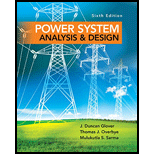
Power System Analysis and Design (MindTap Course List)
6th Edition
ISBN: 9781305632134
Author: J. Duncan Glover, Thomas Overbye, Mulukutla S. Sarma
Publisher: Cengage Learning
expand_more
expand_more
format_list_bulleted
Concept explainers
Textbook Question
Chapter 9, Problem 9.32P
For the system of Problem 9.13, compute the fault current for the following faults at bus 3: (a) a single line-to-ground fault through a fault impedance
Expert Solution & Answer
Want to see the full answer?
Check out a sample textbook solution
Students have asked these similar questions
R₁
W
+10 V
R3
+9 V
C₂
R₁
CA
C₁
470 pF
HH
1000 pF
HH
1 με
C4
1 μF
1 uF
C₁
R₂
R4
100 pF
Find
Open-loop
Jain
L₁
5 mH
(a)
Av=S,B={"
H
R₁₂
✓
ww
(b)
R₁
L₁
000
1.5 mH
R₂
H
1 uF
12
10 mH
A) Calculate the efficiency of the test transformer at the resistive
loads (X-25%, 50%, 75%, 100%, 125% full load).
B) From part (A) draw the plot (efficiency Vs power output) of the
transformer.
C) Discuss the plot of part (B).
a- Determine fH; and Ho
b- Find fg and fr.
c- Sketch the frequency response for the high-frequency region using a Bode plot and
determine the cutoff frequency.
Ans: 277.89 KHz; 2.73 MHz; 895.56 KHz; 107.47 MHz.
14V
Cw=5pF
Cwo-8pF
Coc-12 pF
5.6kQ
Ch. 40. pF
C-8pF
68kQ
0.47µF
Vo
0.82 kQ
V₁
B=120
0.47µF
www
3.3kQ
10kQ
1.2kQ
=20µF
N
Chapter 9 Solutions
Power System Analysis and Design (MindTap Course List)
Knowledge Booster
Learn more about
Need a deep-dive on the concept behind this application? Look no further. Learn more about this topic, electrical-engineering and related others by exploring similar questions and additional content below.Similar questions
- Using D flip-flops, design a synchronous counter. The counter counts in the sequence 1,3,5,7, 1,7,5,3,1,3,5,7,.... when its enable input x is equal to 1; otherwise, the counter. This counter is for individual settings only need the state diagram and need the state table to use 16 states from So to S15.arrow_forward: A sequential network has one input (X) and two outputs (Z1 and Z2). An output Z1 Z2 = 10 occurs every time the input sequence 1011 is completed. An output Z1 Z2 = 01 occurs every time the input sequence 0101 is completed. Otherwise Z1 Z2 = 0 Find Moore state diagram with minimum number of states: a) When overlap is allowed. b) When overlap is not allowed. I need a step by step printable solution that uses sequences on the same drawing.arrow_forward1. Consider a negative unity-feedback control system whose plant transfer function is type- 1. Suppose you want to build a lead compensator so that -3 ± 5j are dominant poles. You observed that the angle deficiency at the desired dominant pole is 50°. Compute a 's+b' and b of the lead compensator (s+ 2) so that the error constant Ky is maximized. In other words, design the lead compensator in a way so that the steady-state error for ramp input is minimumarrow_forward
- EXAMPLE 8.12 The E-MOSFET of Fig. 8.40 was analyzed in Example 7.10, with the result that k = 0.24 × 103 A/V², VGS = 6.4 V, and ID = 2.75 mA. a. Determine gm- b. Find rd. c. Calculate Z; with and without rd. Compare results. d. Find Zo with and without ra. Compare results. e. Find A, with and without rd. Compare results. 카 1 uF Z RE 912 V Rp • 2 ΚΩ 10 ΜΩ HE 1 μF ID (on) = 6 mA VGS (on) = 8 V VGS (Th) = 3 V 80s = 20 μs Za o Voarrow_forwardNO AI PLEASEarrow_forwardNO AI PLEASEarrow_forward
- I need handwritten solution to this, electrical engineering expert tutor s only,this is an assignment,I need 100% accuracyarrow_forward5. Determine the CT convolutions for the signals below. Sketch the signal that flips and on same plot the one that is not flipped. Do this for each overlap case. Clearly indicate all overlap cases and the integral limits. Finally, using the left squiggly bracket notation, show the output for each case versus time. (c) 4 x(t) 2 1 2(t) 4 x(t) 4 0123 et 20 x(t) (4) 4 (a) +(1) 24 T 0123 (b) T (f) 1 2-2 0123 (c) (f) 0123 (d) (1) A t 1(8) 4,121 -101 3 (e)arrow_forwardSolve by pen and paper not using chatgpt or AI Find the current io, and the voltage vo in the circuit in Figure 4. Answer: ἱο = 1.799 Α, νο = 17.99 V.arrow_forward
- "Hi Tutor, Please solve this question manually without using AI tools. AI solutions are often inaccurate in advanced electrical engineering. If you're unable to solve it manually, kindly let another qualified tutor assist me. I need reliable and accurate solutions. Thank you."arrow_forwardQ3: A conducting filamentary triangle joins points A(3, 1, 1), B(5, 4, 2), and C(1, 2, 4). The segment AB carries a current of 0.2 A in the аAB direction. There is present a magnetic field B = 0.2a, -0.1a,+ 0.3a, T. Find: (a) the force on segment BC; (b) the force on the triangular loop; (c) the torque on the loop about an origin at A; (d) the torque on the loop about an origin at C.arrow_forwardI want to find the current by using mesh analysis pleasearrow_forward
arrow_back_ios
SEE MORE QUESTIONS
arrow_forward_ios
Recommended textbooks for you
 Power System Analysis and Design (MindTap Course ...Electrical EngineeringISBN:9781305632134Author:J. Duncan Glover, Thomas Overbye, Mulukutla S. SarmaPublisher:Cengage Learning
Power System Analysis and Design (MindTap Course ...Electrical EngineeringISBN:9781305632134Author:J. Duncan Glover, Thomas Overbye, Mulukutla S. SarmaPublisher:Cengage Learning

Power System Analysis and Design (MindTap Course ...
Electrical Engineering
ISBN:9781305632134
Author:J. Duncan Glover, Thomas Overbye, Mulukutla S. Sarma
Publisher:Cengage Learning
Fault Analysis in Power Systems part 1a; Author: GeneralPAC: Power System Tutorials;https://www.youtube.com/watch?v=g8itg4MOjok;License: Standard youtube license